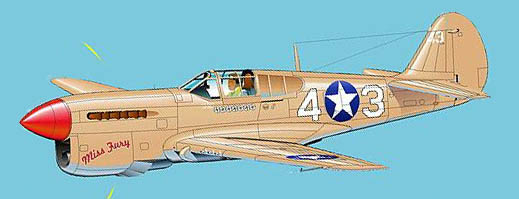    |
 |


| RANK: - WWII Rank of Major - Colonel, USAF Retired
BORN: EDUCATION: COMBAT UNITS: |
ASSIGNED COMBAT
AIRCRAFT*: CREW: VICTORIES: Silver Star Distinguished Flying Cross w/ OLCs Air Medal w/ 15 OLCs Distinguished Unit Citation British Distinguished Flying Cross |
| REMARKS: Roy Whittaker joined the Army Air Corps and was accepted as an Aviation Cadet. He took Primary Flight Training in the PT-17 and PT-18 at Cuero Field, Texas. He went on to Basic Flight Training at Randolph Field, Texas in the BT-9 and BT-14. Whittaker reported to Advanced Flight Training at Kelly Field, Texas and flew the AT-6. As the Commandant of Cadets of Class 41-I, Whittaker received his pilot's Wings and a commission of 2nd Lieutenant in the Army Air Corps on December 12, 1941. He then served as a Flight Instructor for a short period at Kelly Field before being assigned to the 65th Fighter Squadron of the recently formed 57th Fighter Group that was training for combat in the Curtiss P-40E Warhawk. The 65th FS was commanded by Capt. Phillip G. Cochran who was the prototype for the character "Flip Corkin" of "TERRY AND THE PIRATES" and the title character "STEVE CANYON" in Milton Caniff's comic strips. Caniff also designed the 65th Squadron's "Fighting Cock" emblem based on their very fiesty Rhode Island Red rooster mascot, "Uncle Bud". 57th FG C.O. Col. Art Salisbury (Brigadier General, USAF Ret.) was also immortalized by Milt Caniff as the character "Art Solitary" in "TERRY AND THE PIRATES." Lt. Whittaker and the rest of the air echelon of the 57th FG arrived to North Africa in the European-African-Middle Eastern Theatre of Operations aboard the aircraft carrier, USS RANGER in June 1942. Whittaker's P-40F Warhawk was the second plane lanched off the RANGER's deck. All of the 57th Group's 72 Warhawks launched from the carrier safely and without incident to land for refueling at Accra, Gold Coast, then on to Wadi Sedina airfield near Khartoum, Sudan where the pilots continued to train for combat. The group moved for further training at Wadi Halfa airfield near Cairo, Egypt in July 1942. The 57th FG then moved to their first base at Muqueibila, Palestine and soon commenced operations attached to 112 Squadron RAF of 239 Wing, Desert Air Force. Lt. Whittaker was among five pilots selected to train with the RAF at Alexandria, Egypt and then pass on what he learned to U. S. pilots. As Montgomery's British 8th Army launched the El Alamein offensive in late October 1942, the 57th FG with its main mission that of Close Support for ground troops, continued to meet the enemy Axis air forces sporatically but now in greater numbers. Lt. Whittaker destroyed an Italian Macchi-Castoldi MC.202 for his first aerial victory on October 26, 1942. Recently promoted Capt. Whittaker and the 57th FG would have their finest day, a slaughter that came to be known as the "Palm Sunday Massacre" for the day of the event, April 18, 1943. Over Cape Bon, Tunisia, an Axis force of *60 Junkers Ju 52 transports escorted by 21 Messerschmitt Bf 109 and MC. 202 fighters were headed for the island of Sicily when they were spotted by patrolling P-40Fs of the 57th FGs three component Squadrons and the 314th FS of the 324th FG with a high cover of RAF Supermarine Spitfire Vs from No. 92 Squadron. The American P-40s dove out of the sun and when the smoke had cleared, 59 Ju 52s and 16 fighters had been shot down for the loss of 6 P-40s - arguably the finest single engagement for the P-40 Warhawks ever. In the massacre, Capt. Whittaker destroyed three Ju 52s and one Bf 109G, plus was credited further with one "Damaged" Ju 52 and one "Damaged" Bf 109G. On this day, Capt. Whittaker closed out his overall aerial "scoring" tally for a total of 7 e/a Destroyed, 2 e/a Probables and 4 e/a Damaged.
Capt. Whittaker rotated home to the USA ZI in June 1943 and following
a short furlough, reported back to Randolph Field, Texas to attend Flight
Instructors School. He attended Gunnery School and subsequently became a
Flight Instructor at the United States Military Academy at West Point, New
York. Capt. Whittaker attended and graduated from the Army Command & Staff
School at Ft. Leavenworth, Kansas in the Summer of 1945. He again served as a
stateside Fighter Pilot with command of the the newly formed 499th FS before
he saw the end of WWII with the rank of Major. * Estimates of as many as 100 Ju 52s and 50+ fighters have been used in some sources to describe the enemy aerial strength during the "Palm Sunday Massacre".
QUOTE/STORY: |



Artwork by Rocky Gooch
Thanks to Mrs. Roy E. Whittaker and Roy E. Whittaker, Jr. for their help in compiling this tribute to Col. Whittaker.
